The LR44 and SR44 batteries are commonly used button/coin cell power sources, each with its unique characteristics and applications. LR44, also known as the IR44 battery, relies on Alkaline Zinc Manganese chemistry, offering a cost-effective and versatile solution for various electronic devices. In contrast, the SR44 battery, with its Silver Oxide chemistry, stands out for its stable voltage output and is often preferred in precision instruments like watches and calculators. Despite differences in chemistry, these batteries share similar dimensions and are frequently interchangeable in many devices.
LR44 VS SR44: Are LR44 and SR44 Interchangeable?
Yes, LR44 and SR44 batteries are often interchangeable in many devices due to their similar dimensions and voltage specifications. Both LR44 and SR44 have a diameter of 11.6mm, a height of 5.4mm, and operate at voltages close to each other (LR44 at 1.5 volts and SR44 at 1.55 volts). Additionally, they share equivalents such as A76, 357, and others, indicating compatibility in various applications.
However, it's important to note that there are differences in their chemistry. LR44 uses Alkaline Zinc Manganese chemistry, while SR44 employs Silver Oxide chemistry. While they may be interchangeable in some devices, the choice between LR44 and SR44 might be influenced by factors like discharge profiles, especially in applications where precise voltage levels are critical.
For devices that are not highly sensitive to the specific chemistry and discharge characteristics, LR44 and SR44 batteries can often be used interchangeably. Let’s explore the differences between LR44 and SR44 battery.
Introduction to LR44 Battery
The IR44 battery, also known as LR44, stands as a ubiquitous button/coin cell power source extensively utilized in diverse electronic devices ranging from toys and remote controls to watches and calculators. Produced by reputable brands, LR44 batteries are available in various chemistries, each tailored to specific application needs.
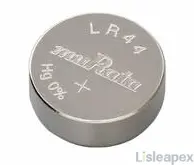
Functioning as an alkaline button cell, the LR44 battery boasts an extended lifespan, compact dimensions (11.6mm diameter, 5.4mm height), and a cost-effective profile. This battery variant is widely accessible in retail outlets due to its popularity for personal use. LR44 batteries are categorized into premium and regular segments, recognized for their endurance, high capacity, energy density, and reliability, attributes influenced by competitive pricing.
For optimal performance when replacing batteries in portable devices, meticulous attention to details such as battery type, dimensions, capacity, maximum voltage or current, shelf life, and chemistry is imperative. Devices sensitive to voltage thresholds may benefit from the substitution of LR44 with Silver Oxide batteries. Alkaline-labeled packaging unequivocally denotes the chemistry of the batteries, providing consumers with a comprehensive understanding of their power source.
IR44 Battery Dimension
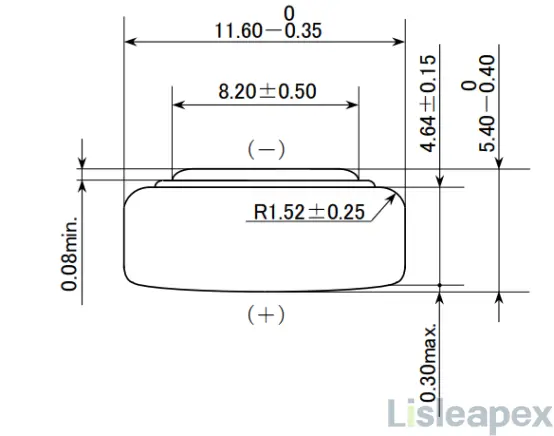
LR44 Specifications
|
Parameter |
Specification |
|
Nominal Voltage |
1.50 Volts |
|
Capacity |
Approximately 115 mAh |
|
Operating Temperature |
0°C – 60°C |
|
Dimensions |
Diameter: 11.6 mm |
|
|
Height: 5.4 mm |
|
Chemistry |
Alkaline (also available in similarly sized variants with silver oxide chemistry) |
Equivalent Of LR44 Battery
The LR44 battery is associated with various equivalent designations, reflecting diverse naming conventions employed by different manufacturers. Below are common alternatives that can be interchangeably used with LR44 batteries:
- AG13: A prevalent alternative designation, AG13 batteries functionally match LR44 batteries, sharing identical size and voltage specifications.
- A76: Widely used interchangeably with LR44, A76 batteries possess the same size and voltage characteristics, providing a seamless substitution.
- 357: Designated as equivalent to LR44 batteries, 357 is part of the SR44 battery series, offering interchangeability with LR44 batteries.
- SR44: As a broader category, SR44 includes batteries with specifications similar to LR44, making them frequently interchangeable.
- L1154: Another equivalent for the LR44 battery, L1154 belongs to the alkaline button-cell battery family, sharing comparable specifications.
- PX76A: Recognized as an alternative designation, PX76A batteries are typically compatible with devices that accept LR44 batteries.
LR44 Battery Application & Uses
The LR44 battery, renowned for its compact size and stable performance, finds widespread application across various devices. Some notable uses include:
- Digital Thermometer: LR44 batteries power digital thermometers, ensuring accurate and reliable temperature readings.
- Calculators: Commonly employed in calculators, LR44 batteries provide a compact and efficient power source for these essential devices.
- Laser Pens: LR44 batteries serve as a reliable energy source for laser pens, contributing to their portability and longevity.
- Flashlights: Compact flashlights benefit from the LR44's stable power supply, making them suitable for emergency and everyday use.
- Security System Panels: LR44 batteries are utilized in security system panels, offering a dependable power solution for continuous operation.
- Wrist Watches: LR44 batteries power wristwatches, combining a small form factor with reliable performance to ensure accurate timekeeping.
- Medical Devices and Instruments: Critical medical devices and instruments, such as glucometers and blood pressure monitors, often rely on LR44 batteries for consistent and precise operation.
- Memory Backup: LR44 batteries play a crucial role in providing backup power for memory in various devices, ensuring data retention during power interruptions.
- Battery Pack Applications: LR44 batteries are utilized in battery packs for specific applications, providing a reliable power source for extended usage.
- Other Common Applications: LR44 batteries are extensively used in a range of everyday devices, including calculators, watches, toys, remote controls, and cameras, where their small size and stable performance make them a preferred choice.
Introduction to SR44 Battery
The SR44 battery, a prominent silver oxide button cell, stands as a preferred power source for renowned brand-name timepieces and various small devices. Widely recognized for its reliability, the SR44 battery is extensively utilized in handheld calculators and other electronic gadgets.
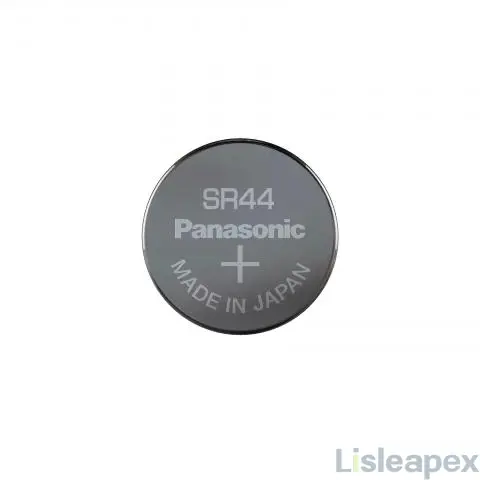
Measuring 11.6mm in diameter and 5.4mm in thickness, the SR44 design is among the most common watch batteries. It shares direct compatibility with LR44, AG13, SG13, 357, and other cells, making it a versatile choice for multiple applications. With an output voltage of 1.55V, the SR44 battery boasts a typical capacity ranging from 170 to 200mAh.
Distinguished by silver oxide technology, SR44 batteries exhibit a consistent voltage of 1.55V throughout most of their discharge cycle. The SR44's ability to provide reliable and uniform performance positions it as a preferred option over LR44 batteries, especially in critical applications where precision is paramount.
SR44 Battery Specifications
The SR44 battery, a button/coin cell with silver oxide chemistry, is known for its compact dimensions (11.6mm diameter, 5.4mm height), lightweight design (typically around 2.5 grams), and consistent power output of 1.55 volts. With a variable but typically around 150mAh capacity, this battery category is commonly available and exhibits a relatively long lifespan. It finds applications in watches, calculators, cameras, and various small electronic devices.
SR44 Battery Specifications Table:
|
Specification |
SR44 Battery |
|
Chemistry |
Silver Oxide |
|
Type |
Button/coin cell |
|
Diameter |
11.6mm |
|
Height |
5.4mm |
|
Weight |
Varies, typically around 2.5 grams |
|
Voltage |
1.55 volts |
|
Capacity |
Varies, typically around 150mAh |
|
Categories |
Commonly available |
|
Life Span |
Relatively long |
|
Applications |
Watches, calculators, cameras, small electronic devices |
SR44 Battery Dimension
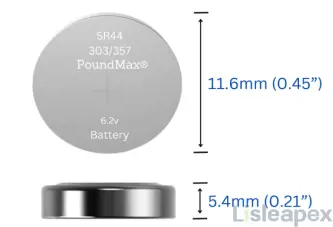
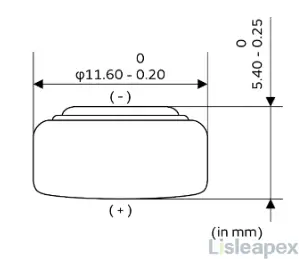
LR44 VS SR44: Chemistry
LR44: The LR44 battery relies on Alkaline Zinc Manganese chemistry, a composition chosen for its stability and efficiency in providing a reliable power source for a variety of electronic devices.
SR44: In contrast, the SR44 battery employs Silver Oxide chemistry, known for its high energy density and stable voltage output, making it particularly suitable for precision applications in timepieces and calculators.
LR44 VS SR44: Voltage
LR44: Operating at a voltage of 1.5 Volts, the LR44 battery offers a standard power output suitable for a range of everyday electronic devices.
SR44: Slightly edging out in voltage, the SR44 battery provides a power level of 1.55 Volts, contributing to its optimal performance in precision instruments like timepieces.
LR44 VS SR44: Use in Device
LR44: Widely employed in a spectrum of devices including watches, motherboards, and various medical instruments like thermometers, the LR44 battery stands as a versatile power source catering to diverse electronic needs.
SR44: Findings its niche in brand-name timepieces, handheld calculators, and a myriad of compact devices, the SR44 battery establishes itself as a preferred choice for applications demanding precision and reliability. Additionally, its compatibility with counterparts such as LR44, AG13, SG13, and 357 enhances its versatility in electronic ecosystems.
LR44 VS SR44: Equivalents
LR44:
The LR44 battery, known by various equivalents such as A76, AG13, L1154, LR1154, and 157, provides a versatile range of replacements for this specific size. While these batteries share the same form factor, it's crucial to note that the LR44 is chemically distinct from silver oxide button cells, including SR44, SR44SW, 303, and 357.
It is common for batteries to fit into devices designed for other equivalents, but their chemical differences should not be overlooked. Using the recommended battery type for your device is essential to prevent over/under discharge issues. Careful consideration of size and voltage is advised to avoid potential damage to your device.
SR44:
The SR44 battery, also known as CR44, 357, SR44W, AG13, G13, A76, A-76, PX76, 675, 1166a, LR44H, V13GA, GP76A, L1154, RW82B, EPX76, SR44SW, 303, S303, S357, SP303, and SR44SW, offers a comprehensive list of equivalents. These batteries are interchangeable in many devices, ensuring flexibility in their usage.
LR44 VS SR44: Price
When comparing LR44 and SR44 batteries, a notable distinction lies in their pricing and performance characteristics. Alkaline LR batteries are generally more budget-friendly compared to silver-oxide alternatives. However, it's essential to consider the trade-off in terms of life expectancy.
Silver-oxide batteries, such as the SR44, demonstrate superior longevity and endurance when compared to alkaline LR batteries. While LR44 batteries may offer a cost-effective solution, the investment in silver-oxide batteries often proves worthwhile due to their extended lifespan. When evaluating these options, it becomes evident that the upfront cost of alkaline LR batteries may be lower, but the longevity and performance of silver-oxide batteries position them as a durable and reliable choice, especially for devices requiring sustained and efficient power over time.
SR44 vs LR44 vs 357
The LR44, 357, and SR44 batteries are button/coin cell options, each with distinct features. LR44 is cost-effective and versatile, suitable for devices with modest power needs. 357, composed of silver oxide, provides stable voltage for watches and calculators. SR44, also silver oxide, offers a slightly higher voltage and interchangeability in devices, considering discharge profile differences. The table highlights key specifications, aiding users in choosing the right battery for their applications.
|
Specification |
LR44 Battery |
357 Battery |
SR44 Battery |
|
Chemistry |
Alkaline |
Silver Oxide |
Silver Oxide |
|
Type |
Button/coin cell |
Button/coin cell |
Button/coin cell |
|
Diameter |
11.6mm |
11.6mm |
11.6mm |
|
Height |
5.4mm |
5.4mm |
5.4mm |
|
Weight |
Approx. 2.5 grams |
Typically 2.5 grams |
Varies (typically 2.5g) |
|
Voltage |
1.5 volts |
1.5 volts |
1.55 volts |
|
Capacity |
Varies |
Typically 150mAh |
Varies |
|
Life Span |
Long |
Relatively long |
Relatively long |
|
Cost |
Low |
Varies (typically higher) |
Varies (typically higher) |
|
Availability |
Widely available in stores |
Widely available in stores |
Widely available in stores |
|
Applications |
Toys, remote controls, watches, calculators, etc. |
Watches, calculators, cameras, small electronic devices, etc. |
Watches, cameras, medical instruments, etc. |
|
Compatibility |
Often interchangeable, especially in devices with lenient power requirements |
Interchangeable in many cases, but differences in discharge profiles should be considered |
Interchangeable, but differences in discharge curves may affect performance |
|
Discharge Profiles |
Sloping |
Stable |
Stable |
You may like: LR44 vs 357: Is LR44 Same as 357
LR vs SR vs MR: What are Main Differences
LR Series Batteries:
Economical and versatile, LR series batteries are commonly used in devices where cost is a primary consideration, offering a nominal voltage of 1.5V and a capacity ranging from 120-150mAh.
SR Series Batteries:
Serving applications demanding stable and slightly higher voltage, SR series batteries, with a nominal voltage of 1.55V and enhanced capacity, are prevalent in watches and electronic devices.
MR Series Batteries:
Historically employed in specific devices like pocket computers, MR series batteries typically operate around 1.4V, with varying capacities, requiring careful consideration for device compatibility.
Choosing the Right Battery:
Select LR for cost-effectiveness, SR for stable higher voltage needs, and adhere to MR for devices with historical specifications. Always consider device requirements, voltage sensitivity, potential recalibration needs, and follow manufacturer recommendations for optimal battery selection.
Conclusion
In conclusion, the LR44 and SR44 batteries play crucial roles in powering a diverse range of electronic devices. While LR44 excels in cost-effectiveness and versatility, SR44 stands out for its stable voltage output, making it ideal for precision applications. The interchangeability of these batteries in certain devices provides users with flexibility, but it's essential to consider factors like chemistry and discharge profiles for optimal performance. Ultimately, understanding the specific needs of your electronic devices will guide you in choosing between LR44 and SR44, ensuring reliable and efficient power solutions.
FAQ
-
Can LR44 and SR44 batteries be used in high-drain devices?
LR44 and SR44 batteries are generally suitable for low to moderate-drain devices. High-drain devices may require more powerful battery types.
-
Are LR44 and SR44 batteries rechargeable?
Generally, LR44 and SR44 batteries are not rechargeable. They are designed for single-use applications. If rechargeability is required, it's advisable to use rechargeable button cell batteries if available.
-
Can LR44 and SR44 batteries be recycled?
Yes, both LR44 and SR44 batteries can be recycled. Many recycling centers accept button cell batteries for recycling to properly handle the disposal of their materials.
-
How long do LR44 and SR44 batteries last?
The lifespan of LR44 and SR44 batteries depends on factors like usage and the specific device. Alkaline LR44 batteries typically have a shorter lifespan compared to silver oxide SR44 batteries, but this can vary.
-
What devices commonly use LR44 and SR44 batteries?
LR44 and SR44 batteries are commonly used in small electronic devices such as watches, calculators, digital thermometers, laser pointers, and various other gadgets.
Stay updated with Lisleapex by signing up for the newsletter


 Congratulations On Your Successful Submission
Congratulations On Your Successful Submission
 Submission Failure
Submission Failure